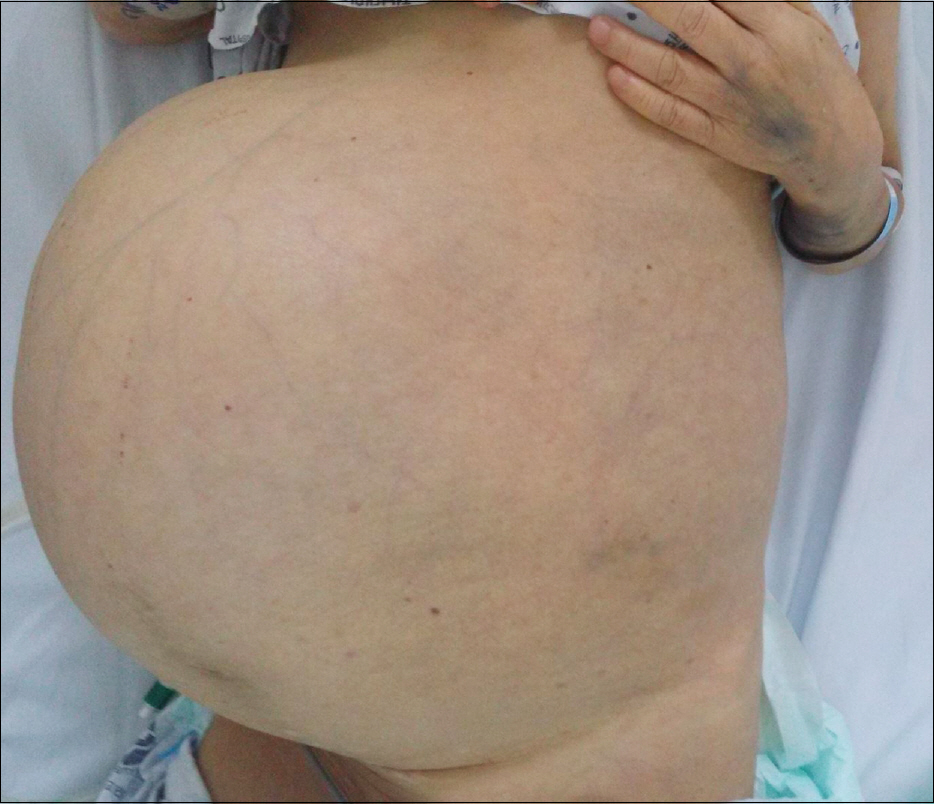Korean J Gastroenterol.
2016 Apr;67(4):220-223. 10.4166/kjg.2016.67.4.220.
Hepatic Hemangioma with Kasabach-Merritt Syndrome in an Adult Patient
- Affiliations
-
- 1Department of Internal Medicine, Chonnam National University Medical School, Gwangju, Korea. choisk@jnu.ac.kr
- KMID: 2373429
- DOI: http://doi.org/10.4166/kjg.2016.67.4.220
Abstract
- Hemangiomas are the most common benign tumors of the liver. They are generally asymptomatic, but giant hemangiomas can lead to abdominal discomfort, bleeding, or obstructive symptoms. Kasabach-Merritt syndrome is a rare but life-threatening complication of hemangioma, characterized by consumptive coagulopathy with large vascular tumors. More than 80% of Kasabach-Merritt syndrome cases occur within the first year of life. However, there are few reports of Kasabach-Merritt syndrome with giant hepatic hemangioma in adults and, as far as we know, no reports of Kasabach-Merritt syndrome with hepatic hemangioma treated with first line medical treatment only. The most important treatment for this syndrome is removal of the large vascular tumor. However, surgical treatment entails risk of bleeding, and the patient's condition can mitigate against surgery. We herein present a case of unresectable giant hepatic hemangioma with disseminated intravascular coagulopathy. The patient was a 60-year-old woman who complained of hematochezia, ecchymosis, and abdominal distension. She refused all surgical management and was therefore treated with systemic glucocorticoids and beta-blockers. After two weeks of steroid therapy, she responded partially to the treatment. Her laboratory findings and hematochezia improved. She was discharged on hospital day 33 and observed without signs of bleeding for three months.
MeSH Terms
-
Abdomen/diagnostic imaging
Ecchymosis/etiology
Female
Gastrointestinal Hemorrhage/etiology
Hemangioma/complications/*diagnosis
Humans
Kasabach-Merritt Syndrome/complications/*diagnosis/drug therapy
Middle Aged
Prednisone/therapeutic use
Propranolol/therapeutic use
Tomography, X-Ray Computed
Prednisone
Propranolol
Figure
Reference
-
References
1. Ishak KG, Rabin L. Benign tumors of the liver. Med Clin North Am. 1975; 59:995–1013.
Article2. Choi BY, Nguyen MH. The diagnosis and management of benign hepatic tumors. J Clin Gastroenterol. 2005; 39:401–412.
Article3. Adam YG, Huvos AG, Fortner JG. Giant hemangiomas of the liver. Ann Surg. 1970; 172:239–245.
Article4. Hall GW. KasabachMerritt syndrome: pathogenesis and management. Br J Haematol. 2001; 112:851–862.
Article5. Kasabach HH, Merritt KK. Capillary hemangioma with extensive purpura. Am J Dis. 1940; 59:1063–1070.
Article6. Enjolras O, Wassef M, Mazoyer E, et al. Infants with KasabachMerritt syndrome do not have "true" hemangiomas. J Pediatr. 1997; 130:631–640.
Article7. Hochwald SN, Blumgart LH. Giant hepatic hemangioma with KasabachMerritt syndrome: is the appropriate treatment enucleation or liver transplantation? HPB Surg. 2000; 11:413–419.8. Meguro M, Soejima Y, Taketomi A, et al. Living donor liver transplantation in a patient with giant hepatic hemangioma complicated by KasabachMerritt syndrome: report of a case. Surg Today. 2008; 38:463–468.
Article9. Malagari K, Alexopoulou E, Dourakis S, et al. Transarterial embolization of giant liver hemangiomas associated with KasabachMerritt syndrome: a case report. Acta Radiol. 2007; 48:608–612.
Article10. Aslan A, Meyer Zu Vilsendorf A, Kleine M, Bredt M, Bektas H. Adult Kasabach-merritt syndrome due to hepatic giant hemangioma. Case Rep Gastroenterol. 2009; 3:306–312.
Article11. McKay MJ, Carr PJ, Langlands AO. Treatment of hepatic cavernous haemangioma with radiation therapy: case report and literature review. Aust N Z J Surg. 1989; 59:965–968.
Article12. el-Dessouky M, Azmy AF, Raine PA, Young DG. KasabachMerritt syndrome. J Pediatr Surg. 1988; 23:109–111.
Article13. Kelly M. KasabachMerritt phenomenon. Pediatr Clin North Am. 2010; 57:1085–1089.
Article14. Seo SK, Suh JC, Na GY, Kim IS, Sohn KR. KasabachMerritt syndrome: identification of platelet trapping in a tufted angioma by immunohistochemistry technique using monoclonal antibody to CD61. Pediatr Dermatol. 1999; 16:392–394.15. Gidding CE, Kellie SJ, Kamps WA, de Graaf SS. Vincristine revisited. Crit Rev Oncol Hematol. 1999; 29:267–287.
Article16. Léauté-Labrèze C, Dumas de la Roque E, Hubiche T, Boralevi F, Thambo JB, Taïeb A. Propranolol for severe hemangiomas of infancy. N Engl J Med. 2008; 358:2649–2651.
Article
- Full Text Links
- Actions
-
Cited
- CITED
-
- Close
- Share
- Similar articles
-
- Two Cases of Kasabach-Merritt Syndrome
- A Case of Kasabach-Merritt Syndrome with Disseminated Intravascular Coagulopathy Treated with Interferon alfa-2a
- Successful Treatment of an Infant with Kasabach - Merritt Syndrome with Interferon Alfa - 2a
- Kaposiform Hemangioendothelioma Complicated by Kasabach - Merritt Phenomenon with Bone Involvement in an Adult
- A Case of Kasabach-Merritt Syndrome



